Embarking on the journey of diamond jewelry shopping today has become simultaneously wonderful and overwhelming. The traditional market comprised of solely mined diamonds has expanded to a new wealth of diamond simulant options. The simulated diamond market has created more beautiful choices than ever before for engagement rings and more, but it has also created confusion as you try to decipher the real difference between simulated lab created diamonds and real diamonds.
Let’s break down the simulated diamond meaning. Simulated lab grown diamonds provide a wonderful diamond alternative to mined diamonds, especially as they are more affordable and environmentally friendly. However, not all lab-created diamonds are the same, and there can be major differences in both quality and price across the range of options.
One of the most significant differences to understand is the one between simulated diamonds vs cubic zirconia. The variations in diamond clarity, durability, and appearance are notable, and understanding them will send you down the right path to finding your perfect diamond.
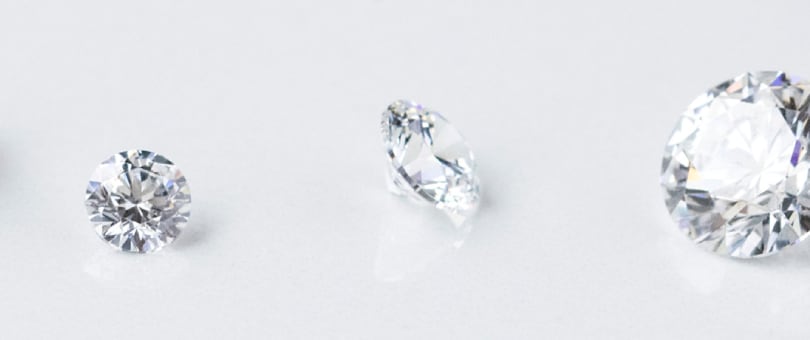
What Is a Simulated Diamond?
Simulated diamonds, also known as diamond alternatives, are stones created in a lab to mimic—or simulate—the look and feel of a mined diamond. These can be made out of various materials, and in most cases, they do not have the same chemical composition as a mined diamond. Given the cost of mined diamonds, seeking to imitate the sparkle and shine of a true natural diamond has led to centuries-long efforts by people looking for a diamond imitation. With this quest has arisen a variety of simulated diamonds, which are categorized as stones that are created in a lab and simulate the look of a diamond. It should be noted that diamond simulants and synthetic diamonds are different from each other.
There are many different types of simulated diamonds, all of which vary in composition, quality, and appearance. Below are some of the most common stones.
- Topaz is made from aluminum and fluorine. It’s as hard as cubic zirconia, but it has prismatic crystals, which means a lower shine.
- Quartz, is sometimes called rock crystal or Herkimer diamonds. This is a very common, naturally occurring mineral. It comes in a range of colors and is often slightly cloudy.
- Leaded glass or crystal. This is a man-made material, with beautiful clarity. But it is very easy to break, chip, or crack.
- Beryl is a natural gemstone with a long history. It comes in many colors, including a transparent white stone. However, it usually contains natural impurities and flaws, which damage the shine and depth of the stone.
- Scheelite occurs naturally and synthetically. However, it is not as popular as other diamond simulants – and it can contain flaws, such as clouds of tiny gas bubbles or lines.
- Sphalerite has a wonderfully high shine, but it is very soft and fragile.
- White zircon is chemically similar to cubic zirconia. It comes in many different colors and has a different crystal structure from diamonds or cubic zirconia.
- Cubic zirconia is one of the finest and most popular diamond substitutes. However, it is less durable than a diamond and can discolor over time.
- Lab created diamond simulants are a new development in diamond jewelry. They offer the clarity, shine, and fire of mined diamonds – without the financial or ethical costs.
The last two categories of simulated diamonds – cubic zirconia and lab created diamond simulants – are of particular importance to examine. They are often the most commonly used substitute for diamonds and have become more popular in engagement rings trends, yet there are significant differences between them.
What is Cubic Zirconia?
Jewelers first started using cubic zirconia as a fake diamond substitute in 1969. Since then, it’s become one of the most popular alternatives to diamonds. Cubic zirconia is a synthetically produced gemstone. That means, instead of being mined from under the earth, it can be produced in clean laboratory conditions. Zirconia can be found naturally, but it is too rare and brittle to be used.
The gemstone is made out of crystalline zirconium dioxide. The laboratory starts with zirconium oxide – a kind of gritty, mineral powder – and heats it to 5000 degrees Fahrenheit. The laboratory mixes in other minerals during the process as well to add color and make the gemstone more resistant.
CUBIC ZIRCONIA APPEARANCE
As it cools, the new mix of minerals naturally forms into cubic crystal shapes. This helps give cubic zirconia its clear, bright, diamond-like shine. Unlike similar stones – such as white zircon – cubic zirconia has fire. Fire is what jewelers call the flash of light that you see from diamonds. Cubic zirconia is hard and smooth, like natural gemstones. It comes in a range of colors, including red, lilac, aqua, amber, and pink. This makes the stone versatile, as it can be used for other gem alternatives in addition to diamonds.
However, although cubic zirconia may start as hard and bright, it is important to be wary because it doesn’t always stay that way. Due to the nature of the chemical composition, cubic zirconia stones are prone to chipping. It also has a tendency to pick up contaminants from the environment over time, which can lead to visible flaws and discoloration.
CUBIC ZIRCONIA COST & ETHICS
Originally, cubic zirconia was created to provide a more affordable alternative to diamonds. Today, it is still easier to purchase than mined diamonds, yet has continued to rise in price as it gained popularity. Now that cubic zirconia is recognized in its own right, you can expect jeweler prices to rise.
Most cubic zirconia is produced in China and Thailand, but in recent years, questions have surfaced as to the conditions of factory workers. If you want to be an ethical consumer, make sure to research where your cubic zirconia was produced.
What is a Lab Created Diamond Simulant?
Diamond simulants are defined as stones created in a lab and aren’t made solely of carbon crystals, as naturally mined diamonds and lab diamonds are. Lab-created diamond simulants are also known as diamond alternatives and include synthetic moissanite and Nexus Diamond™ alternatives.
Diamond simulants are created in a lab in order to manipulate the characteristics and seek to emulate the colorless, flawless, and durable nature of a perfect diamond.
LAB CREATED DIAMOND SIMULANT APPEARANCE
Diamond simulants can actually be of higher quality than some natural diamonds. The average natural diamond engagement ring is rated G for color and VS1 for clarity – meaning it’s slightly yellow in color with a few tiny flaws in the stone. It also often doesn’t have the same quality of cut that can be achieved with a diamond simulant.
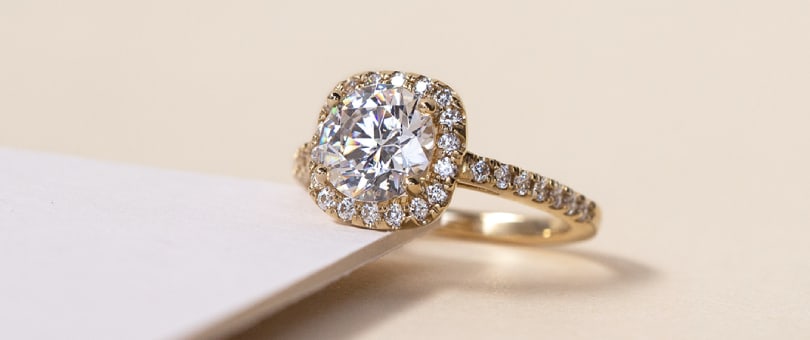
However, the actual qualities will vary based on the precise chemical composition of the diamond simulant. For example, Diamond Nexus lab created alternatives are made with a patented formula, which makes it chemically different from a natural diamond. It is also crafted in the lab to be completely colorless, internally flawless, and Ideal Cut. The quality of the stone will retain over time, just as those of every unique natural diamond do. Other man made diamond simulants will vary in quality based on the composition of the stone in the lab process.
LAB CREATED DIAMOND SIMULANT COST & ETHICS
In addition to the advantages diamond simulants have in regard to quality, they also are produced in a manner that is environmentally friendly and ethical. Unlike conventionally mined diamonds, lab created simulants aren’t reliant on strip mining, with its associated pollution and poor working conditions.
When purchasing a diamond simulant, consumers don’t have to worry about the environmental and ethical concerns of the blood diamond trade, because the stones are not mined.
Moreover, lab diamond simulants offer all the beauty and peace of mind that you get from ethical, natural diamonds – without the high price tag. In fact, Nexus Diamond alternatives can cost up to 80% less than conventionally mined diamonds. If you’re considering how much to spend on an engagement ring, these alternatives can provide a wonderful solution.
Cubic Zirconia vs. Lab Created Diamond Simulants
The biggest differentiating factors between cubic zirconia and lab created diamond simulants are their unique color, clarity, durability, and weight.
While cubic zirconia has a wonderful shine, it does not always maintain its color and clarity over time. The chemical composition is porous, so the stone is vulnerable to pollution or contaminants in the environment. This will cause the stone to cloud and discolor, gradually fading from brilliant whiteness to a muddy yellow or brown.
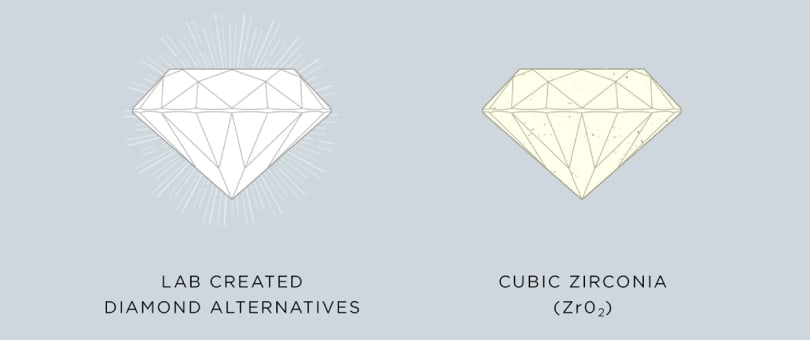
Diamond simulants such as Nexus Diamond alternatives are created to be colorless and internally flawless. Moreover, they’re composed of a chemical structure that enables them to maintain these qualities forever.In relation to durability and hardness, there is an obvious difference as well. Nexus Diamond alternatives are heirloom-quality, guaranteed not to crack, and designed to last forever. On the other hand, cubic zirconia is rated softer than Nexus Diamonds on the Mohs scale of hardness. Consequently, it risks chipping from wear and tear even after a few months.
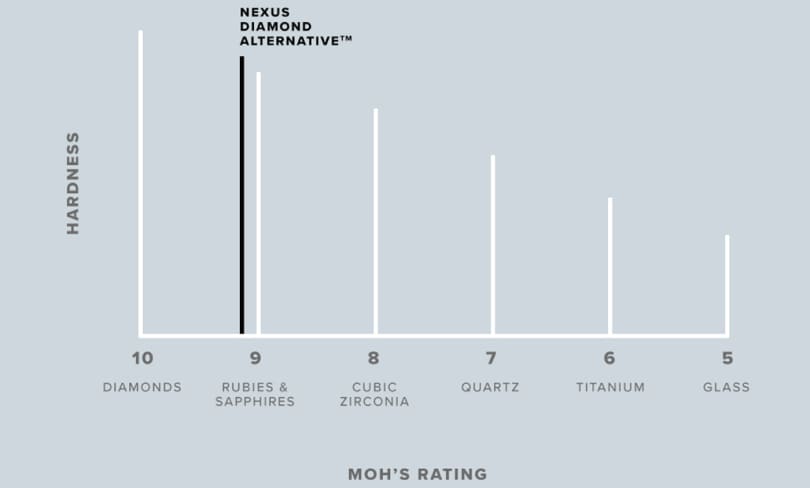
A final important quality is the stone’s weight. Cubic zirconia is 75% heavier than diamonds. As such, it can be uncomfortably heavy to wear, and you’ll need stronger, heavier metal settings to support the gemstone.In contrast, diamonds and other lab grown diamond simulants are lighter. They don’t just look clear and pure; they feel like it, too. You can find engagement rings, earrings, and even statement necklaces with elegant, light settings and opulent man made diamond simulants, and they will still be a joy to wear.
Choosing a Diamond to Last a Lifetime
Diamond jewelry is an incredibly personal purchase. No one else can tell you which stone to choose, or why. But when you are shopping for diamonds and diamond simulants, consider the wealth of options available today and weigh them on the following factors: quality, appearance, longevity, price, and environmental impact.
When choosing an engagement ring or another piece of jewelry, take the time to research your choice of diamond substitutes and alternatives. Don’t be afraid to ask your jeweler lots of questions! Make sure that you are delighted with your decision.
A precious stone can be a symbol of love, a family heirloom, and a lifetime investment. If you wear your jewelry every day – such as an engagement ring – then you will see that gemstone all the time. There’s an opportunity for that piece to collect more meaning and memories every day. Find the perfect diamond ring for you, one that will keep its brilliance forever and last a lifetime.
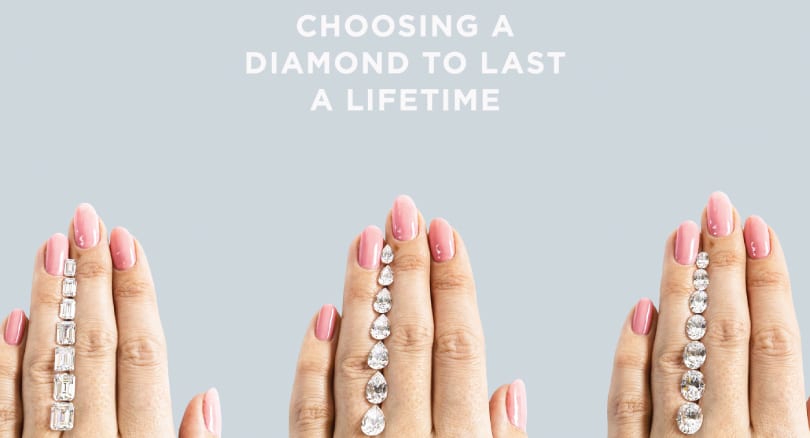
*Diamond Nexus strives to provide valuable information, while being clear and honest about products. The Nexus Diamond™ alternative is a patented lab created stone that, among all simulants, most closely imitates the look and wear of a perfect diamond, with two exceptions – it is absolutely perfect in every way, and it costs significantly less. Price points expressed in this blog were taken from popular online retailers and may vary. Learn more about the environmental impact of mining on our blog.
